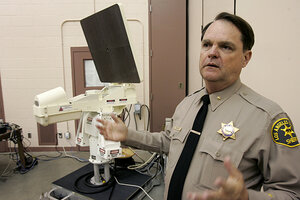America's prisoners: Should we shoot them with a giant ray gun?
Officials at the Los Angeles County sheriff's department are testing a directed-energy weapon that causes pain, but apparently no tissue damage. Should we start using it against prisoners?

Los Angeles County Sheriff's Department Commander Bob Osborne discusses the Assault Intervention Device, a microwave ray gun that causes intense pain, but is said to be nonlethal.
ZUMA Press/Newscom
Prison guards might soon test an invisible laserlike beam that triggers a painful burning sensation as a new way to break up fights between inmates.
The project does not yet have the green light from its federal sponsor. But should it go forward, officials plan to set up the beam-emitting machine, known as Assault Intervention Device (AID) in a dormitory at the North County Correctional Facility at the Pitchess Detention Center in Castaic, Calif.
"This device allows us to stop a fight or lessen the severity of it without inflicting injury," said Cmdr. Bob Osborne of the Los Angeles County Sheriff’s Department.
Pain like a "hot stove"
As a directed-energy weapon, the AID is laserlike in concept, though its beam is in the invisible millimeter range of the spectrum. The AID's ray penetrates one-sixty-fourth of an inch (0.4 millimeter) into the skin, down to the location of our pain receptors.
"In terms of pain, it's like brushing against a hot stove or an iron," Osborne said, who has experienced the AID's effects many times.
Yet the AID does not cause actual burning of the skin or nerve damage, according to Raytheon, the makers of the weapon and its parent device, the Silent Guardian, several units of which have been sold to the United States military.
"You instinctively yank your hand away, and then you look at [your hand] and there's nothing there," Osborne said. "You go, 'Boy, that’s hot, but I'm not injured,' and that's what we love about the device."
"All the other tools we have," Osborne said, such as batons or pepper spray, "hurt people."
Getting the AID up and running
The Los Angeles County Sheriff’s Department initially slated the 7 1/2 -foot (2.3 meter)-tall AID for installation last year in a dormitory that houses about 65 inmates.
Correctional officers would operate the device from a station that oversees the dorm's common area. The AID's interface is very much like a video game: It includes a basic computer monitor with a crosshair-esque marker on it and a joystick with a trigger.
To avoid shining at a human target for longer than necessary or intended, the device only fires for a few seconds for each trigger press; to resume firing, the trigger must be released and depressed again, Osborne explained.
The AID trial is funded by the Department of Justice's research, development and evaluation agency, the Washington, D.C.-based National Institute of Justice (NIJ). Although the AID was unveiled in Sep. 2010, the NIJ has decided to review the project further before moving forward, Osborne said.
At any rate, the current prototype is not what Osborne ultimately envisions as the tool of choice in regulating prisoner fights in California jails or elsewhere.
"This device isn’t what we want the device of future to look like," Osborne said. "It's way too big and costly, it's too hard to install, it has too much equipment. Before anybody does a whole lot of work to miniaturize this thing, the question that needs to be asked is, 'Does it work in real life?’ It works in labs and when people are pretending to be angry and violent, but we don’t know if it works if someone is really assaulting somebody."
The best weapons are rarely used
Given Osborne and his deputies' great discomfort at the receiving end of the AID's beam, however, he thinks the device will be up to the task.
"If I were to bet, I'd bet it'll have an effect," Osborne said, both in suppressing inmate rumbles and, once some prisoners feel the AID ray firsthand, preventing fisticuffs in the first place.
"It's a conflicting feeling — we'd like to be able to use [the AID] … But we're not rooting for a fight to break out," he added.
"But if violence does occur, we'd like to deal with it in an appropriate manner."
• New Laser May Sniff Out Bombs and Pollutants
• New CSI Camera ‘Sees’ Invisible Blood Stains
• Top 7 Teenage Tech Criminals

